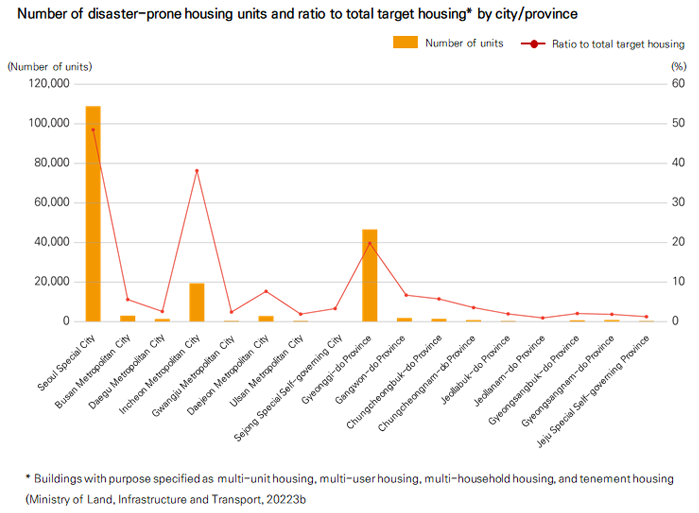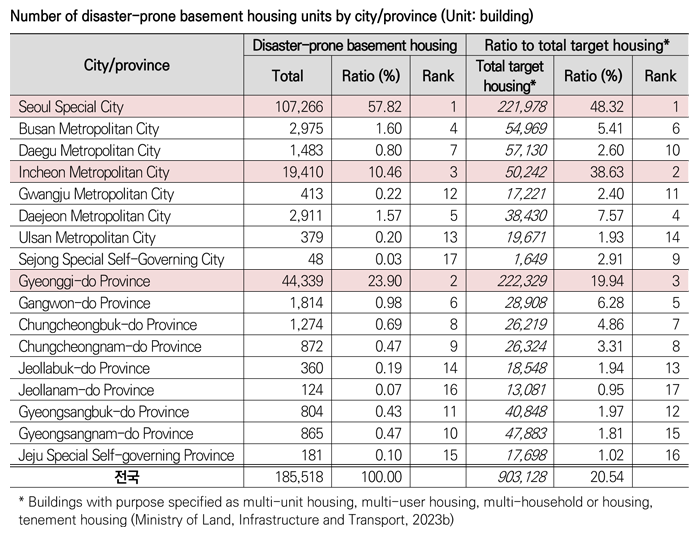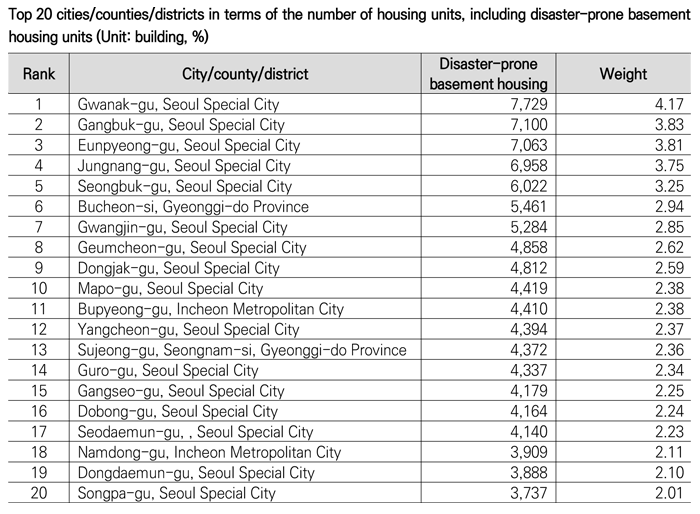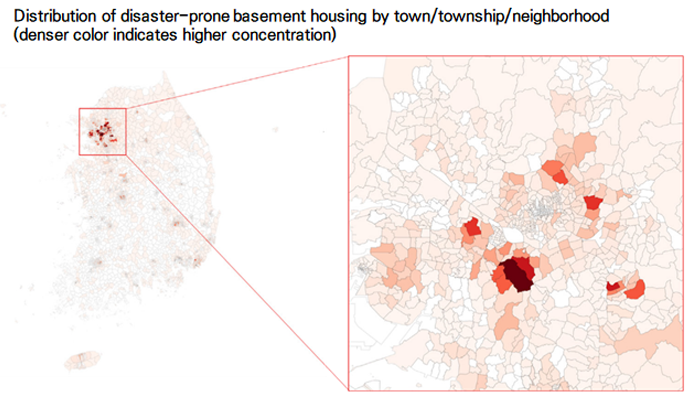Publication
auri Research Brief
Disaster-Prone (Semi-)Basement Houses, How Many and Where?
- No.85
- 2023.07.24
- Hit 14291
- Ahn, Euisoon Associate Research Fellow
- Park, Jonghoon Associate Research Fellow
- Song, Yumi Assistant Research Fellow
The vulnerability of (semi-)basement housing was highlighted again with the concentrated number of casualties during the heavy rainfall in August of 2022. Based on private architectural administrative data, an analysis of the current status of disaster-prone basement housing (including multi-user houses, multi-unit houses, tenement houses, and multi-household houses that are over 20 years or have a masonry structure) revealed a total of 185,518 buildings nationwide. In particular, 92% of disaster-prone basement housing was found to be located in the Seoul metropolitan area, including Seoul, Gyeonggi, and Incheon. For a more precise estimation of disaster-prone basement housing, it is essential to establish measures that link architectural administrative data with topographic data and other spatial information.
Residential Environment Vulnerability of Basement Housing
In August of 2022, the central region of the country was hit by record-breaking torrential rainfall exceeding 490 mm over two days, resulting in significant property damage and a loss of life (Kim, 2022). It was observed that a majority of the casualties occurred among residents of basement (semi-basement) housing, bringing attention to the vulnerability of such housing to disasters. In October, the deaths of basement housing residents due to fires (Jeong, 2022) further highlighted the vulnerability of basement housing, not only natural disasters but also to situations such as crime and fires.
The government recognizes the vulnerability of basement (semi-basement) housing and aims to improve residential environments and ensure national safety by revising the Guidelines on Housing Support for Disadvantaged Groups (July 2020). The revised guidelines include an additional provision of housing support to basement households at risk of flooding and not meeting the minimum housing standards. Support is provided for public rental housing relocation, security deposits, moving expenses, and more (Ministry of Land, Infrastructure and Transport, 2020, p.19). Additionally, the government has announced the National Housing Stability Plan (August 2022), which includes surveys on disaster-prone basement housing1) and residents (Ministry of Land, Infrastructure and Transport, 2022). In principle, the construction of new basement housing is prohibited, and designated development areas are allowed if more than half of the housing units are on basement floors (Park, 2023).
Local governments are also taking measures to address the vulnerability of basement housing. They are revising urban and residential environment improvement ordinances to reduce the requirement of over 20 years after completion for basement housing. For Incheon and Gyeonggi-do Province, after the revision of the ordinances, the standard for old buildings is set to the lower limit of 20 years for residential complexes that have structures consisting of materials other than reinforced concrete or steel frames or that use basement floors for residential purposes (Article 3, Appendix 1 of “Gyeonggi-do Province Urban and Residential Environment Improvement Ordinance,” Article 3 of “Incheon Metropolitan City Urban and Residential Environment Improvement Ordinance”). Similar revisions to ordinances are being pursued in other municipalities, such as Seoul.
History and Legal Changes of Basement Housing
Basement housing, commonly referred to as “banjiha” (half-basement), is a representative type of vulnerable housing that gained international recognition through the movie Parasite. When the Building Act was established in 1962, the installation of living spaces in basements was generally prohibited. However, under certain conditions where there were no hygiene issues, houses in the form of “banjiha” with windows were allowed. In 1970, the installation of basements for air-raid shelters became mandatory, and due to housing shortages resulting from industrialization, the proportion of basements being used as residential units increased. In 1975 and 1982, the government practically allowed basement housing by removing the prohibition on the installation of living spaces in basements. In 1981, the condition that excluded non-living areas from volume calculations for basement floor area was removed, creating an economic incentive to build basement housing by not including the basement floor area in volume calculations.
However, since the 1990s, as private car ownership increased, the demand for parking spaces also grew, leading to changes in housing types. The obligation to install parking facilities within houses was strengthened, and when installing elevated ground-level parking structures (pilotis), not only were these areas excluded from volume calculations, but they were also excluded from the number of floors in the housing. As a result, the construction of multi-story buildings with elevated parking structures on the first floor increased, and consequently, the construction of basement housing naturally decreased.
In the future, it is expected that basement housing will decrease through a ban on new construction and gradual redevelopment. In 2012, regulations were newly established in the Building Act prohibiting the construction of basement housing in flood-prone areas or in areas at risk of frequent flooding (Building Act. Act No. 11182. Article 11 (4) 2). In February 2023, a plan was announced that strictly prohibits the construction of basement housing and that will gradually phase it out (Ministry of Land, Infrastructure and Transport, 2023a).
Analysis of Disaster-Prone Basement Housing Based on Open Architectural Administrative Data
Architectural administrative data refers to the data produced, held, and managed during the building administrative process. According to Article 32 (1) of the Building Act and Article 22-2 (1) of the Enforcement Rules of the same Act, building permission affairs are processed through the building administrative system (Seumteo). In accordance with Article 17 of the Act on Promotion of the Provision and Use of Public Data, the Ministry of Land, Infrastructure and Transport provides architectural administrative data for buildings nationwide to the public through an open system for architectural data (open.eais.go.kr).
For this survey, unprocessed raw data from building registers (as of December 2022), which manage buildings status of buildings nationwide, were used for the analysis. The format of the large-scale building register data provided by the open system is text, and the size of the floor summary data, which is necessary for an analysis of basement housing status, reaches approximately 20 million rows. To handle such large-scale data, the Python-based big data analysis package Dask (www.dask.org) was utilized for an exploratory analysis and for the extraction of the final list of disaster-prone basement housing.
The criteria for extracting disaster-prone basement housing were based on the history and architectural characteristics of basement housing, including building usage, years of use, structure, and the installation of elevated parking structures (pilotis). Firstly, if the basement is used for purposes such as multi-unit housing, multi-user housing, multi-household housing, or tenement housing, it was considered as basement housing. However, if the ground floor is marked for elevated parking, i.e., pilotis, indicating that the ground floor is located at the reference plane height, it is deemed as not having basement housing and is excluded from the analysis.
The vulnerability of basement housing to disasters was assessed based on the recent trend of urban and housing environment regulations in Seoul, Gyeonggi-do Province, and other areas regarding criteria for aged and defective buildings. If the years of use for basement housing exceeded 20 years (prior to the end of 2002, the analysis reference point), it was considered as an aged and defective building vulnerable to disasters. Additionally, considering the different criteria for years of use between steel and concrete structures and other structures in the criteria for aged and defective buildings, basement housing with a masonry structure was considered as disaster-prone regardless of the number of years of use.

Regional Statistics of Disaster-Prone Basement Housing
According to the survey results, the total number of disaster-prone basement housing nationwide was found to be 185,518 units. When examining the statistics by region, it was revealed that 92.2% of the disaster-prone basement housing was located in a metropolitan area, including 107,266 units in Seoul, 44,339 units in Gyeonggi, and 19,410 units in Incheon. The proportion of disaster-prone basement housing compared to the total number of target housing units (including multi-unit houses, multi-user houses, multi-household houses, and tenement houses) was also significantly higher in Seoul (48.32%), Incheon (38.63%), and Gyeonggi (19.94%) compared to non-metropolitan areas.

When examining the level of basic local government units (cities, counties, districts), Seoul's Gwanak-gu had the highest number, at 7,729 buildings, classified as disaster-prone basement housing, followed by Gangbuk-gu (7,100 buildings), Eunpyeong-gu (7,063 buildings), Jungnang-gu (6,958 buildings), and Seongbuk-gu (6,022 buildings). Among the top 20 local government units with the highest number of vulnerable basement housing units, all were located in Seoul, Gyeonggi-do Province, and Incheon. When examining the level of administrative districts (eup, myeon, dong), it was observed that disaster-prone basement housing was particularly concentrated in certain areas within the capital region. In particular, Sillim-dong in Gwanak-gu, Seoul, which experienced significant flooding damage during the concentrated heavy rainfall in August of 2022, had the highest number of disaster-prone basement housing units at 4,534 buildings among all administrative districts nationwide. Apart from Gwanak-gu, other areas with dense clusters of disaster-prone basement housing units were identified, such as Myeonmok-dong in Jungnang-gu, Mia-dong in Gangbuk-gu, Hwagok-dong in Gangseo-gu, and Doksan-dong in Geumcheon-gu.



Need to Integrate Architectural Administrative Data with 3D Spatial Information
The analysis of disaster-prone basement housing status was conducted based on architectural administrative data, which is open to the private sector as public data. The analysis took into account the usage of basement floors, building structures, and aging conditions to produce statistics on the distribution of disaster-prone basement housing by region (by city/province, by city/country/district, by town/township/neighborhood). The distribution of disaster-prone basement housing identified through this survey corresponded to the actual flood-prone areas, such as Sillim-dong in Gwanak-gu, Seoul, which experienced concentrated flood damage in August of 2022. The statistics on disaster-prone basement housing derived from this survey can serve as a basis for formulating policies aimed at disaster prevention and damage abatement.
However, the current architectural administrative datasets do not include elevation information for each floor of a building, which limits the assessment of vulnerability in relation to flooding. Therefore, the results of this survey require verification through on-site investigations and other means. To assess the susceptibility to flooding in basement housing more accurately based on architectural administrative data, it is necessary to incorporate elevation (altitude) information for basement floors and ground surfaces, as well as topographic information for the surrounding areas. In the long term, it is important to establish three-dimensional spatial information, including the height of each floor of a building, and to integrate this data with architectural administrative data.
1) Semi-basement and non-residential dwellings (gosiwon (dormitory-style single room), shacks, vinyl greenhouses, and others)
- Act on Promotion of the Provision and Use of Public Data. Act No. 17344.
- Building Act. Act No. 11182.
- Enforcement Rules of the Building Act. Ministry of Land, Infrastructure and Transport Order No. 1224.
- Seoul Special City Urban and Residential Environment Improvement Ordinance. Seoul Special City Ordinance No. 8734.
- Gyeonggi-do Province Urban and Residential Environment Improvement Ordinance. Gyeonggi-do Province Ordinance No. 7629.
- Incheon Metropolitan City Urban and Residential Environment Improvement Ordinance. Incheon Metropolitan City Ordinance No. 6978.
- Architectural Data Open System. https://open.eais.go.kr/
- Inter-ministry collaboration (2022). National Housing Stability Plan.
- Ministry of Land, Infrastructure and Transport. (2020). Housing and Welfare Roadmap 2.0.
- Ministry of Land, Infrastructure and Transport. (2022). National Housing Stability Plan Presentation. Press release, August 16.
- Ministry of Land, Infrastructure and Transport. (2023a). Measures to Enhance Urban and Housing Resilience to Climate Change.
- Ministry of Land, Infrastructure and Transport. (2023b). 7,354,340 Buildings Nationwide with a Floor Area of 4,130 Million ㎡. Press release, March 2. http://www.molit.go.kr/USR/NEWS/m_71/dtl.jsp?lcmspage=1&id=95087983 (Search date: 2023.5.16.)
- Kim, Y. (2022). 500 mm of Heavy Rainfall, 18 Dead or Missing... Continues to Pour Today. The Dong-a Ilbo. News article, August 10. https://www.donga.com/news/article/all/20220810/114887428/1 (Search date: 2022.11.3.)
- Park, C. (2023). Ban on Construction of Semi-Basement Housing... Relaxation of Floor Area Ratio for Redevelopment in Dense Areas. Yonhap News. News article, February 22. https://www.yna.co.kr/view/AKR20230222064951003 (Search date: 2023.2.22.)
- Ahn, E. & Park, J. (2023). Analysis of Disaster-Prone Basement Housing Based on Architectural Administrative Data. AURI (to be published).
- Yoon, B. (2022). Semi-Basement Housing Vulnerable to Heavy Rain Disappearing in Seoul Due to Complete Prohibition. Yonhap News. News article, August 10. https://www.yna.co.kr/view/AKR20220810138500004?section=search (Search date: 2022.11.3.)
- Jeong, H. (2022). "Another Semi-basement Tragedy" Fire in Semi-Basement Room in Mapo-gu... Young Man Found Under Window Guard. JoongAng Ilbo. News article, October 11. https://www.joongang.co.kr/article/25108412 (Search date: 2022.10.28.)
- Guidelines on Housing Support for Disadvantaged Groups. Ministry of Land, Infrastructure and Transport Instruction No. 1361. 2021.1.22. Partially amended.
- Dask. https://www.dask.org/
